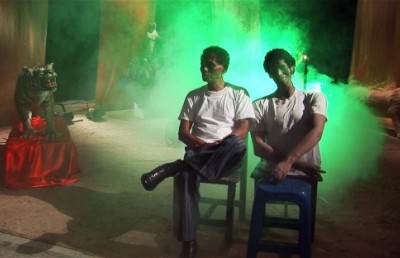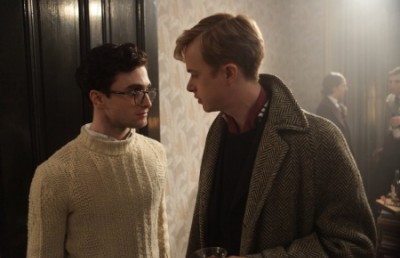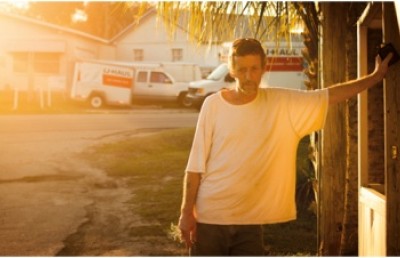Room 237: Experimenting with documentary and film criticism
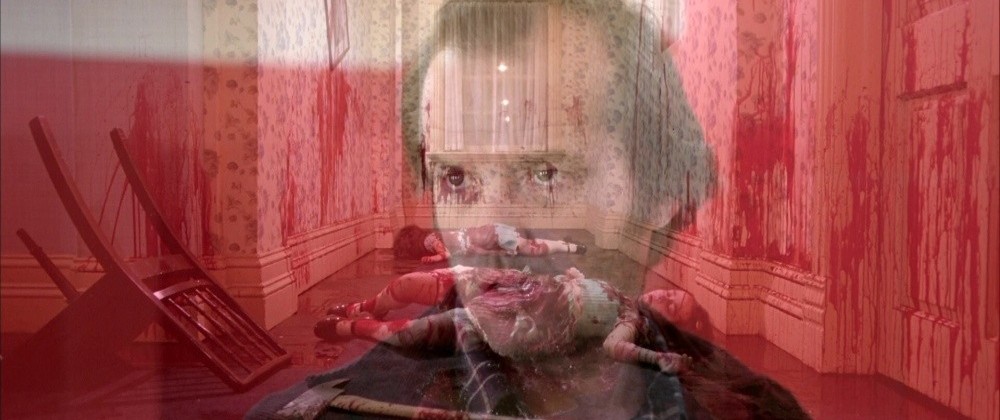
Rodney Ascher’s Room 237 is an inventive hard to categorize film which turns the difficult trick of becoming its subject. Ostensibly a documentary on Stanley Kubrick’s The Shining, Room 237 is also a new form of film criticism, one which charts a different course than the standard film criticism. Many critics have complained that director Ascher’s voice is absent in the film, which lets five cinephiles obsessed over The Shining vent their interpretative muscles on The Shining. Ascher first names the five characters, Bill Blakemore, Geoffrey Cocks, John Fell Ryan, Juli Kearns, and Jay Weidner, but then lets their voices come and go unidentified, all of which is suggestive of a stream of consciousness form of thinking.
But what transpires is not a film that sets out to explain The Shining or critique or defend the five major arcing interpretations on offer, but that the whole discourse is an echo of the film itself. The Shining is a film about a family who slowly become possessed by the evil spirits of the Overlook Hotel (even though there is room to interpret otherwise, that the ghosts are not physically real); Room 237 presents to us five cinephiles who have just as slowly become possessed by the power of this film.
In a recent book on film criticism, The Language and Style of Film Criticism, edited by Andrew Klevan and Alex Clayton, a few of the essays contextualize the changing face of film criticism, and how it is in the process of expanding away from the dominance of the explanatory, language-based film criticism to one that is both more dependent on multi-media and on personal reflection. “The continuum of critical work thus produced ranges from the analytical and explanatory to the more poetical and expressive” (Keathley, p. 179). This comment expresses how in film criticism, thanks in large part to the growth of online film communities (blogs, critical websites, file sharing networks, etc.) the gap between scholarly and non-scholarly film writing has narrowed. The first cinephile to speak in Room 237, Bill Blakemore, a former ABC news correspondent, tells us how the advent of DVD technology revolutionized how he could study Kubrick’s films, with the ability to pause, rewind, freeze and slow down the film giving him a new lease on his creativity. The expansion of the ability to watch more films and watch film more intensely and more readily on the internet through streaming, file sharing, downloading, film swapping, Youtube, and password protected links has led to what critic Chuck Klusterman calls “Immersion Criticism”.
Immersion Criticism is not for the feint hearted film critic, “because it can’t really be done unless you watch a movie 10 or 100 or 1,000 times. It’s based on the belief that symbolic, ancillary details inside a film are infinitely more important than the surface dialogue or the superficial narrative. And it’s not just a matter of noticing things other people miss, because that can be done by anyone who’s perceptive; it’s a matter of noticing things that the director included to indicate his true, undisclosed intention. In other words, it’s not an interpretive reading — it’s an inflexible, clandestine reality that matters way more than anything else. And it’s usually insane” (Klusterman). It is a criticism that comes only after watching a film an innumerable amount of times and in a non-natural way, that is, by looking at the background of shots, little details, and not for the story.
With immersion film criticism the critic does not simply watch a film once and then write their thoughts out but watch the film over and over again until they begin to see things that the average viewer could not see after one viewing; meaning things that were either unconsciously placed there by the filmmakers, consciously ‘hidden’ in the film, or ideas that are sparked into live by the critic, or a creative encounter between the critic and the film, or a combination of the above that leads to a stream of consciousness thought process. With this kind of immersive film writing, the critic presents a new form which seems to express Asher’s film well: “A simultaneous faithfulness to the object of study and an imaginative use of it” (p. 183). Producer Tim Dirks and director Rodney Asher are the first to admit that Room 237 is a film born on and of the internet. Laura Mulvey notes how modern viewing technology has changed criticism, through the key concept of ‘delay’, the “slowing down the flow of the film” (quoted by Keathley, 176); we see Asher doing this all the way through, literally and figuratively.
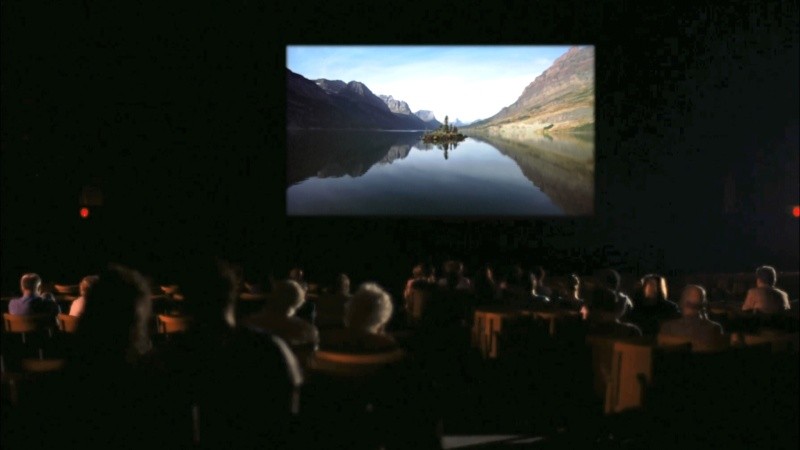
New technologies have not revolutionized ALL film criticism, which is still largely explanatory writing; it has done so profoundly in some cases, where there is a merging between using image, sound, editing, text and voice-over (certain audio-visual essays). The old school of film criticism was explanatory (language-based); and new film criticism that is not just reliant on language to express criticism, meaning, and motion, moves away from the explanatory model and becomes poetic or performative (using the full multi-media spectrum). The affect is more rhetorical and performative than regular film criticism; which is why as a film Room 237 challenges both film criticism and the documentary mode.
The recent film critics who are exploiting this new form of critical expression the most are the ones with a stronger and more active online presence, including cine-bloggers Catherine Grant (Film Studies for Free), Jim Emerson (The Chicago Sun-Times), Kevin B. Lee (Shooting Down Pictures), Matt Zoller Seitz (The House Next Door, Moving Image Source), Tony Zhou, and konogada; many of these video essays are still primarily language based; Adrian Martin cites Godard’s “History of Cinema” series as an example of a video essay form that moves away from the language based explanatory mode; not that there isn’t language, there is a lot, but because the language is NOT explanatory; it gets lost with other images, montage, language pattern, text, etc. and does not explain but describe and reflect.
In contrast to the explanatory mode is the poetical mode, an example being Paul Malcolm’s ‘Notes Toward a Project on Citizen Kane’ where images from the film are manipulated (a la found footage, which is what Godard’s film is); rather than the original score or soundtrack he uses a hypnotic piece by Sigur Ros. Malcolm exploits and explores a fuller range of the multi-media potential of the internet than Matt Seitz or Tag Gallagher. Still tied to the printed word but in the non-explanatory mode nonetheless is Susan Howe’s, “Sorting Facts; or, Nineteen Ways of Looking at Marker,” which blends autobiographical and poetic interludes with pictures and drawings.
The Shining is a film I like quite a lot but which has never slipped into my upper echelon of horror films. Like many people of my generation, my first viewing of it was hampered by my association with the King novel on which it is based. I had just read the novel and was lined up to see the film on its opening day in Montreal. My first gut reaction to the film was tepid. No matter how hard I thought or tried to rationalize Kubrick’s film as his story, I was upset that it was not the supernatural story (with a social subtext about alcohol and domestic abuse) that King’s novel was. But I have since grown to admire it, like a precious art piece, even though never falling in love with it. Perhaps this in itself is a reflection of how important the emotional impact of a first viewing is to one’s over-all sense of worth and value. Room 237 has made me think of The Shining in a way I never thought of or thought possible. I never imagined that The Shining could be a puzzle film or an art film with such ambiguous layering. Until I saw Robbe-Grillet and Alain Resnais’ Last Year at Marienbad a few years after seeing The Shining. Then it struck me that The Shining is a film nestled somewhere in between Stephen King’s novel and Robbe-Grillet & Resnais Marienbad! But no one had ever brought forth that hypothetical projection….until Room 237, which indirectly, channels the interpretative gamesmanship of the Über-text of narrative labyrinths, Last Year at Marienbad, onto Kubrick’s The Shining. Hence what Room 237 did for my appreciation of The Shining was open me up to the possibility of how ‘thick’ it can be in terms of subtext.
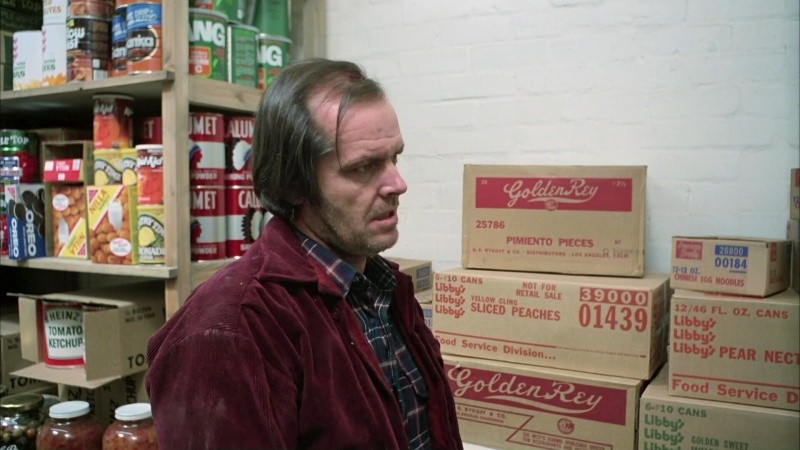
And just how far your subtext can go is what Room 237 is all about. In Room 237 the five critics perform vastly different readings on The Shining. Bill Blakemore sees the film as a metaphor for the genocide of North American Natives, pointing to (among other elements) the highly visible presence in the film of a particular prop, cans of Calamut Baking Soda that have the image of an Indian as its label. Juli Kearns is obsessed with the architectural inconsistencies of the hotel and provides detailed floor plans of the hotel, ‘proving’ that the interview room does not conform to the hotel’s lay out because it can’t have an exposed open wall, hence window. Jay Weidner thinks that the film is Kubrick’s veiled revelation that he was behind the staged moon landing of Apollo 11.
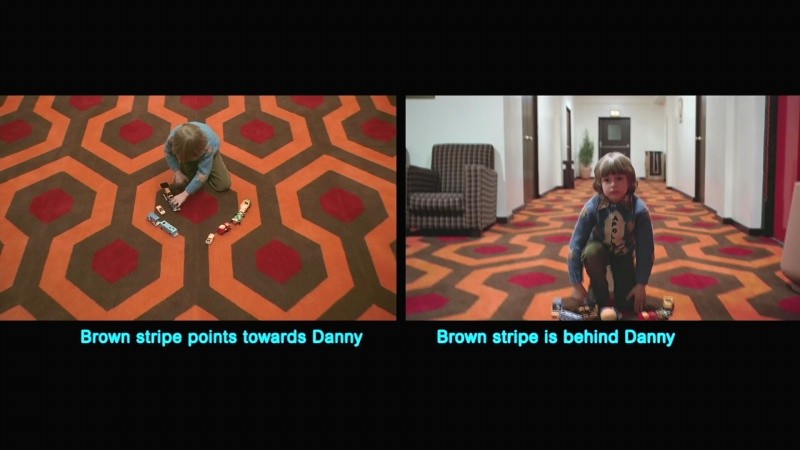
Film historian Geoffrey Cocks reads the film for hidden meanings that reveal a subtext of the Holocaust, focusing on the number 42, the year the Nazis decided on their plan to genocide the Jews (noting a shirt with the number 42 on it, the film Summer of ’42 playing on the TV set, and the numerical configuration 2 × 3 × 7 = 42); and then there is John Fell Ryan, who provides the most fascinating and non-language based approach to the film. Ryan was inspired by an über-rigorous online exegesis of The Shining and a particular line “The Shining is a film meant to be watched both forwards and backwards.” Ryan took this idea literally and plays two versions of the film superimposed over each other, one going through the projector forward and the other backward, and then studies the film for weird synchronicities.
Along with the fanciful interpretations that all five critics make, they also provide some irrefutable factual anomalies, errors or production brain teasers. We may not agree with how they interpret such facts, but they are fascinating in themselves, on some base level (especially if you consider how methodical Kubrick was in never leaving things to chance). For example, why do certain props disappear between continuous shots, like the sticker of one of the Seven Dwarves, Dopey, on Danny’s bathroom door; the chair behind Jack’s typewriter that is in one shot but not another; the carpet pattern that changes direction between shots; Bill Watson’s pants that change design during the interview meeting; the maze in front of the hotel that is visible in some shots but is not in others; the Adler German typewriter that changes color? And then what to make of the infamous red elevator doors that bleed? Is the color red supposed to invoke the disparaging stereotype of the ‘red’ Indian, as Blakemore suggests? And what about the famous ‘Room 237’ and the arcane bits of trivia Jay Weidner provides: the distance from the moon to the earth is approximately 237,000 miles; the way it echoes the hotel room at the end of 2001 (the film which convinced NASA that Kubrick was the person to stage their moon landing)? And how the letters on the red 237 key tag (‘room no” 237) can spell ‘room’ and ‘moon’. All of this may not amount to a coherent meaning, but it sure is a lot of fun.
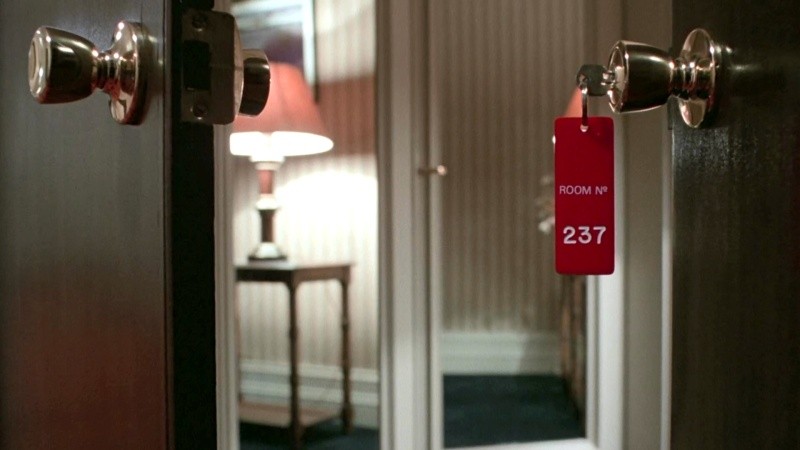
Is Room 237 performing an explanatory analysis of The Shining? Or is Room 237 “…a new kind of ‘critical writing, ’one in which ‘film material [is] literally detached from the original site to become part of the creative material of another work, while still serving a critical function, one referring back to the primary work and illuminating something about it in the manner of conventional criticism” (p. 189).
My own pleasure I derive from the film leads me to think of the film as a performance piece; film criticism as performance; the way it disguises the authorship; the way it modifies the original by slowing it down, pausing it, changing the sound, manipulating shots from the original; juxtaposing other films with The Shining in the tradition of the found footage film; we see clips from Murnau’s Faust (have these five critics also sold their soul to the Devil?); Demons, Demons 2 (Lamberto Bava’s cinephilic, reflexive masterpiece) and Creepshow. All of these changes are performed without signposts, leaving it up to the audience to decipher what is authentic and what is performative; a whole study can be made of the film clips Asher interpolates throughout the film, providing an internal meta-commentary on the ideas of the five critics; it can be seen as a redux of The Shining.
I think this hits home as a conscious decision on director Asher’s part when he concludes with John Fell Ryan, who took The Shining and made a performance out if it by running the film backward/forward in superimposition, a gesture which magically yields critical and interpretative power, and wild synchronicities, like when the winding mountain road from the opening which Ryan tells us was completed in 1921 becomes superimposed with the date 1921 from the end photo, and the way the credits line up Jack Nicholson over his photograph and the yellow Volkswagen he is driving; or evocative overlays, like the image of Jack’s face over the murdered twins, with the blood and curtains causing streaks down Jack’s face which make him look like a twisted clown ; this is a pure example of how meaning does not have to be placed there by filmmaker.
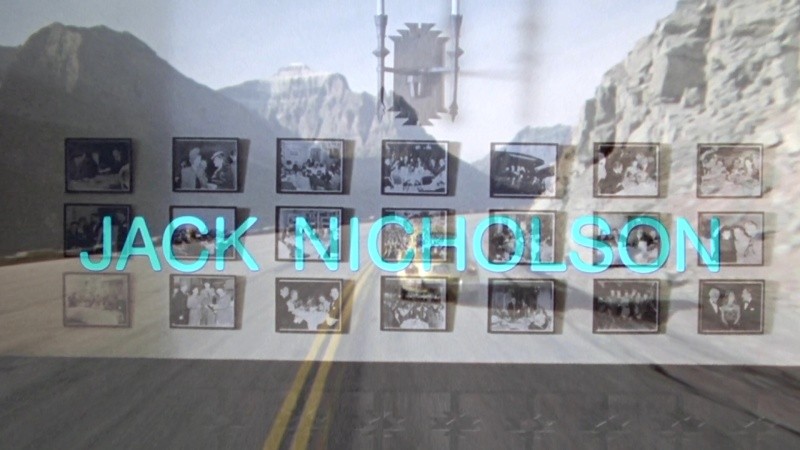
As Ryan notes, much of Immersion Criticism ends up being about the critic as much as the object of study; the line between the two becomes blurred. He states,
Once you start studying synchronicity and symbolism, then you begin to notice in your own life, things you had not noticed before, your point of view is being altered by your study, and its quantum physics, you know, the act of observing, like, affects the thing observed.
Shining: the backwards/forwards extract
Bibliography
Keathley, Christian, “La caméra-stylo: notes on video criticism and cinephilia,” The Language and Style of Film Criticism .ed. Andrew Klevan, Alex Clayton, 2 Park Square Milton Park, Abingdon, Oxon: Routledge, 2011, 176-191



